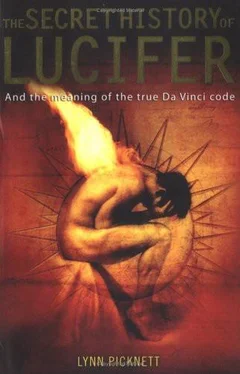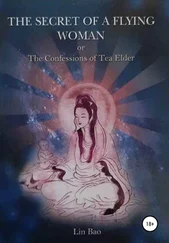Discovering the code
In the early 1990s Clive Prince and myself were busily researching the secrets of the great Florentine Maestro Leonardo da Vinci, for what became our first joint book, Turin Shroud: In Whose Image? The Shocking Truth Unveiled (1994), its subtitle becoming the more self-explanatory How Leonardo da Vinci Fooled History for the 2000 paperback. Our discovery of a mass of circumstantial evidence that suggested strongly he had created the allegedly miraculously imaged Holy Shroud of Turin using a primitive photographic technique will be discussed later, when analysing Leonardo's Luciferan credentials. For now, suffice it to say that as we became convinced of Leonardo's intimate link to the `Shroud', our homes rapidly disappeared beneath a mass of Leonardo reproductions, which we habitually scrutinized minutely for any clues as to what he really stood for. Concentrate as we might, however, our eventual discoveries seemed always to operate on an unconscious level - apparently spontaneously - as if a coiled spring was released explosively in our minds as a reaction to hours of intense staring. We `suddenly' saw the most astonishing things in what are, after all, the most famous works of art, and therefore the most familiar images, in the world. However, these were not simply the equivalent of imagining faces in the fire or animal shapes in cloud formations: gradually the features we had noted and our discoveries about Leonardo's own particular brand of heresy came together as an utterly consistent, coherent whole.
That he intended posterity to notice his hidden clues is certain, and reflects his attitude, as revealed in his contempt for the typical poet because `he has not the power of saying several things at one and the same time' 67 One of the first of the `hidden' symbols we discerned in The Last Supper proved astonishingly blatant, yet like everyone else for 500 years we had succumbed to the blanket of assumption that veiled our eyes. In 1994 we wrote:
Look at the figure of Jesus with his red robe and blue cloak and look to the right where there is what appears at first glance to be a young man leaning away. This is generally taken to be John the Beloved - but in that case, should he not be leaning against Jesus' `bosom' as in the Bible? Look yet more closely. This character is wearing the mirror image of Jesus' clothing: in this case a blue robe and red cloak, but otherwise the garments are identical ... [and] ... as much as Jesus is large and very male, this character is elfin and distinctly female. The hands are tiny, there is a gold necklace on show ... This is no John the Beloved: this is Mary Magdalene. And a hand cuts across her throat, in that chilling Freemasonic gesture indicating a dire warning 68
Yet if we thought we could safely leave The Last Supper behind us, we were sadly mistaken. Its symbolism proved central to our next co-authored work, The Templar Revelation: Secret Guardians of the True Identity of Christ (1997) and was of enormous significance for my own Mary Magdalene: Christianity's Hidden Goddess (2003): with each book we had something new, exciting and disturbing - like all Leonardo's secrets - to present. This trend continues here, with a major new revelation. But first, the essential background:
In the Last Supper the young `St John' leaning as far as possible away from Jesus to make a giant `M' shape with him, indicating the real identity of the character, appeared in our second book, and has also reached a huge international audience through The Da Vinci Code, which used our work as the inspiration for the whole concept of Leonardo's codes and secrets. Yes, clearly this is Mary Magdalene, her mirror-image clothes revealing her to be Christ's `other half', taking what many heretics would have believed to be her rightful place at his side as he initiates the great Christian sacrament in which the wine represents his sacrificial blood and the bread his body. And, as I noted in Mary Magdalene, the hand that makes the vicious slicing motion across the woman's neck belongs to Saint Peter, whom the Gnostic gospels make clear actually had threatened her ... But how was a 15th-century Italian painter to know about the fraught relationship of those two long-dead disciples? Did he have access to the forbidden books that were circulating in the south of France a few centuries before his birth? (Certainly he understood the value of secrets, writing about `truth and the power of knowledge'.) And why did Leonardo believe she ought to be sitting at Jesus' right hand during the Last Supper?
Perhaps he knew something about the original gospels that remains elusive even to the twenty-first century. In their book Jesus and the Goddess: The Secret Teachings of the Original Christians (2001), Timothy Freke and Peter Gandy claim that the biblical Gospel of Saint John, `if it is to bear any name at all, should be The Gospel of Mary Magdalene.' They explain that although it claims to be written by `an unspecified "Beloved Disciple", it is attributed to John solely on the basis of ... Irenaeus, at the end of the second century, claiming he had a childhood memory of being told that the gospel was written by the disciple John.'69 Noting that the late firstcentury Gnostics attributed it to their master Cerinthus, they add
Modem research suggests that the `Beloved Disciple' he makes the narrator of the story is not John, but Mary Magdalene ... The Gospel of the `Beloved Disciple' has been modified ... in order to turn the `Beloved Disciple' Mary into the male figure of John, who was more acceptable to misogynist Literalists.70
Taken in this context - however speculative - the following passage describing the biblical Last Supper after Jesus announces that one of his followers will betray him has a particular significance, if `Mary' is substituted for `the disciple whom Jesus loved':
One of them, the disciple whom Jesus loved, was reclining next to him. Simon Peter motioned to this disciple and said, `Ask him which one he means.'
Leaning back against Jesus, he asked him: `Lord, who is it?'"
It is interesting to note that Peter tacitly admits the status of the Beloved by asking him/her to ask Jesus for information - recall how Mary hogged the floor during the question-and-answer session reported in the Pistis Sophia, and how she and Jesus clearly enjoyed their mutual and no doubt intimate secrets. And in this version of the verses the Beloved is leaning familiarly against Christ at the dinner table. (However, if this really were the Magdalene, such a flaunting of her intimacy with Jesus would have flown totally in the face of what was considered decent behaviour in that time and place. Far from cuddling up to Jesus in front of all his male colleagues, even a legal wife would have kept her distance and modestly supervized the preparation of the meal in the kitchens.)
The originator of this intriguing hypothesis, Ramon K. Jusino, (largely based on the research of Raymond E. Brown,72 although the controversial conclusion is Jusino's own) argues that as `there was a concerted effort on the part of the male leadership of the early church to suppress the knowledge of any major contributions made by female disciples' . . . `much of Mary Magdalene's legacy fell victim to this suppression', ascribing the Fourth Gospel's alleged authorship to John the Evangelist to the crafty work of an early `redactor' (or editor) who basically wrote her out, changing the grammatical gender. He comments that `there is more evidence pointing to her authorship of the Fourth Gospel than there ever was pointing to authorship by John' .73
Jusino cites certain tantalizing structural inconsistences in St John's Gospel as evidence of reworking to an anti-Magdalene agenda. Arguably the most convincing example is the following passage, which has Mary and the anonymous male Beloved Disciple together at the foot of the cross: `Near the cross of Jesus stood his mother, his mother's sister, Mary the wife of Clopas, and Mary Magdalene. When Jesus saw his mother there, and the disciple whom he loved standing nearby, he said ..."
Читать дальше












